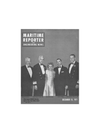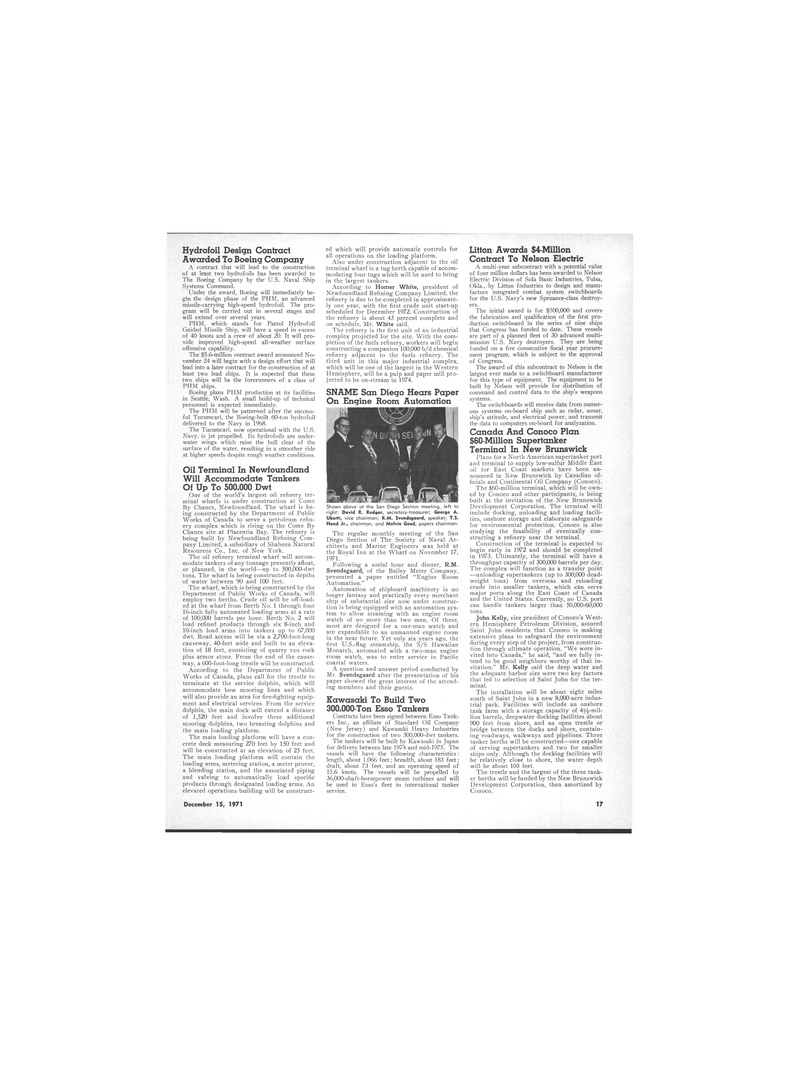
Page 15: of Maritime Reporter Magazine (December 15, 1971)
Read this page in Pdf, Flash or Html5 edition of December 15, 1971 Maritime Reporter Magazine
Hydrofoil Design Contract
Awarded To Boeing Company
A contract that will lead to the construction of at least two hydrofoils has been awarded to
The Boeing Company by the U.S. Naval Ship
Systems Command.
Under the award, Boeing will immediately be- gin the design phase of the PHM, an advanced missile-carrying high-speed hydrofoil. The pro- gram will be carried out in several stages and will extend over several years.
PHM, which stands for Patrol Hydrofoil
Guided Missile Ship, will have a speed in excess of 40 knots and a crew of about 20. It will pro- vide improved high-speed all-weather surface offensive capability.
The $5.6-million contract award announced No- vember 24 will begin with a design effort that will lead into a later contract for the construction of at least two lead ships. It is expected that these two ships will be the forerunners of a class of
PHM ships.
Boeing plans PHM production at its facilities in Seattle, Wash. A small build-up of technical personnel is expected immediately.
The PHM will be patterned after the success- ful Tucumcari, the Boeing-built 60-ton hydrofoil delivered to the Navy in 1968.
The Tucumcari, now operational with the U.S.
Navy, is jet propelled. Its hydrofoils are under- water wings which raise the hull clear of the surface of the water, resulting in a smoother ride at higher speeds despite rough weather conditions.
Oil Terminal In Newfoundland
Will Accommodate Tankers
Of Up To 500,000 Dwt
One of the world's largest oil refinery ter- minal wharfs is under construction at Come
By Chance, Newfoundland. The wharf is be- ing constructed by the Department of Public
Works of Canada to serve a petroleum refin- ery complex which is rising on the Come By
Chance site at Placentia Bay. The refinery is being built by Newfoundland Refining Com- pany Limited, a subsidiary of Shaheen Natural
Resources Co., Inc. of New York.
The oil refinery terminal wharf will accom- modate tankers of any tonnage presently afloat, or planned, in the world—up to 500,000-dwt tons. The wharf is being constructed in depths of water between 90 and 100 feet.
The wharf, which is being constructed by the
Department of Public Works of Canada, will employ two berths. Crude oil will be off-load- ed at the wharf from Berth No. 1 through four 16-inch fully automated loading arms at a rate of 100,000 barrels per hour. Berth No. 2 will load refined products through six 8-inch and 10-inch load arms into tankers up to 67,000 dwt. Road access will be via a 2,700-foot-long causeway, 40-feet wide and built to an eleva- tion of 18 feet, consisting of quarry run rock plus armor stone. From the end of the cause- way, a 600-foot-long trestle will be constructed.
According to the Department of Public
Works of Canada, plans call for the trestle to terminate at the service dolphin, which will accommodate bow mooring lines and which will also provide an area for fire-fighting equip- ment and electrical services. From the service dolphin, the main dock will extend a distance of 1,520 feet and involve three additional mooring dolphins, two breasting dolphins and the main loading platform.
The main loading platform will have a con- crete deck measuring 270 feet by 150 feet and will be constructed at an elevation of 25 feet.
The main loading platform will contain the loading arms, metering station, a meter prover, a blending station, and the associated piping and valving to automatically load specific products through designated loading arms. An elevated operations building will be construct- ed which will provide automatic controls for all operations on the loading platform.
Also under construction adjacent to the oil terminal wharf is a tug berth capable of accom- modating four tugs which will be used to bring in the largest tankers.
According to Homer White, president of
Newfoundland Refining Company Limited, the refinery is due to be completed in approximate- ly one year, with the first crude unit start-up scheduled for December 1972. Construction of the refinery is about 43 percent complete and on schedule, Mr. White said.
The refinery is the first unit of an industrial complex projected for the site. With the com- pletion of the fuels refinery, workers will begin constructing a companion 100,000 b/d chemical refinery adjacent to the fuels refinery. The third unit in this major industrial complex, which will be one of the largest in the Western
Hemisphere, will be a pulp and paper mill pro- jected to be on-stream in 1974.
SNAME San Diego Hears Paper
On Engine Room Automation
Shown above at the San Diego Section meeting, left to right: David R. Rodger, secretary-treasurer; George A.
Uberti, vice chairman; R.M. Svendsgaard, speaker; T.S.
Hand Jr., chairman, and Melvin Good, papers chairman.
The regular monthly meeting of the San
Diego Section of The Society of Naval Ar- chitects and Marine Engineers was held at the Royal Inn at the Wharf on November 17, 1971.
Following a social hour and dinner, R.M.
Svendsgaard, of the Bailey Meter Company, presented a paper entitled "Engine Room
Automation."
Automation of shipboard machinery is no longer fantasy and practically every merchant ship of substantial size now under construc- tion is being equipped with an automation sys- tem to allow steaming with an engine room watch of no more than two men. Of these, most are designed for a one-man watch and are expandable to an unmanned engine room in the near future. Yet only six years ago, the first U.S.-flag steamship, the S/S Hawaiian
Monarch, automated with a two-man engine room watch, was to enter service in Pacific coastal waters.
A question and answer period conducted by
Mr. Svendsgaard after the presentation of his paper showed the great interest of the attend- ing members and their guests.
Kawasaki To Build Two 300,000-Ton Esso Tankers
Contracts have been signed between Esso Tank- ers Inc., an affiliate of Standard Oil Company (New Jersey) and Kawasaki Heavy Industries for the construction of two 300,000-dwt tankers.
The tankers will be built by Kawasaki in Japan for delivery between late 1974 and mid-1975. The vessels will have the following characteristics: length, about 1,066 feet; breadth, about 183 feet; draft, about 73 feet, and an operating speed of 15.6 knots. The vessels will be propelled by 36,000-shaft-horsepower steam turbines and will be used in Esso's fleet in international tanker service.
Litton Awards $4-Million
Contract To Nelson Electric
A multi-year subcontract with a potential value of four million dollars has been awarded to Nelson
Electric Division of Sola Basic Industries, Tulsa,
Okla., by Litton Industries to design and manu- facture integrated combat system switchboards for the U.S. Navy's new Spruance-class destroy- ers.
The initial award is for $500,000 and covers the fabrication and qualification of the first pro- duction switchboard in the series of nine ships that Congress has funded to date. These vessels are part of a planned fleet of 30 advanced multi- mission U.S. Navy destroyers. They are being funded on a five consecutive fiscal year procure- ment program, which is subject to the approval of Congress.
The award of this subcontract to Nelson is the largest ever made to a switchboard manufacturer for this type of equipment. The equipment to be built by Nelson will provide for distribution of command and control data to the ship's weapons systems.
The switchboards will receive data from numer- ous systems on-board ship such as radar, sonar, ship's attitude, and electrical power, and transmit the data to computers on-board for analyzation.
Canada And Conoco Plan $60-Million Supertanker
Terminal In New Brunswick
Plans for a North American supertanker port and terminal to supply low-sulfur Middle East oil for East Coast markets have been an- nounced in New Brunswick by Canadian of- ficials and Continental Oil Company (Conoco).
The $60-million terminal, which will be own- ed by Conoco and other participants, is being built at the invitation of the New Brunswick
Development Corporation. The terminal will include docking, unloading and loading facili- ties, onshore storage and elaborate safeguards for environmental protection. Conoco is also studying the feasibility of eventually con- structing a refinery near the terminal.
Construction of the terminal is expected to begin early in 1972 and should be completed in 1973. Ultimately, the terminal will have a throughput capacity of 300,000 barrels per day.
The complex will function as a transfer point -—unloading supertankers (up to 300,000 dead- weight tons) from overseas and reloading crude into smaller tankers, which can serve major ports along the East Coast of Canada and the United States. Currently, no U.S. port can handle tankers larger than 50,000-60,000 tons.
John Kelly, vice president of Conoco's West- ern Hemisphere Petroleum Division, assured
Saint John residents that Conoco is making extensive plans to safeguard the environment during every step of the project, from construc- tion through ultimate operation. "We were in- vited into Canada," he said, "and we fully in- tend to be good neighbors worthy of that in- vitation." Mr. Kelly said the deep water and the adequate harbor size were two key factors that led to selection of Saint John for the ter- minal.
The installation will be about eight miles south of Saint John in a new 8,000-acre indus- trial park. Facilities will include an onshore tank farm with a storage capacity of 4i/2-mil- lion barrels, deepwater docking facilities about 900 feet from shore, and an open trestle or bridge between the docks and shore, contain- ing roadways, walkways and pipelines. Three tanker berths will be constructed—one capable of serving supertankers and two for smaller ships only. Although the docking facilities will be relatively close to shore, the water depth will be about 105 feet.
The trestle and the largest of the three tank- er berths will be funded by the New Brunswick
Development Corporation, then amortized by
Conoco.
December 15, 1971 17

 14
14

 16
16
